Endangered and Threatened Animal Species of Alabama
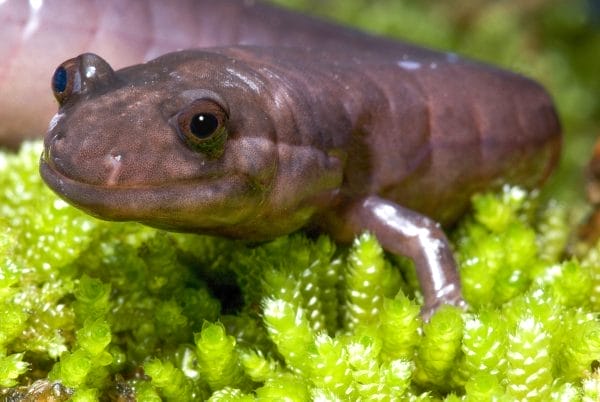 Red Hills Salamander
The U.S. Fish and Wildlife Service (USFWS) currently lists 128 endangered or threatened species in Alabama, of which 105 are animals and 23 are plants. These species are protected from human impact on both private and public lands and include mostly aquatic or water-dependent species. Rapidly increasing human population growth and the resulting conversion of habitat for human use has led to a strong need for protection of wildlife and its habitats. In 1973, the U.S. Congress recognized this need and passed the Endangered Species Act (ESA). This legislation, combined with individual state laws, allows species to be listed at the state, federal, or international level, depending on the distribution and rarity of that species. The list is overseen by the Department of Interior and regulated primarily by the USFWS.
Red Hills Salamander
The U.S. Fish and Wildlife Service (USFWS) currently lists 128 endangered or threatened species in Alabama, of which 105 are animals and 23 are plants. These species are protected from human impact on both private and public lands and include mostly aquatic or water-dependent species. Rapidly increasing human population growth and the resulting conversion of habitat for human use has led to a strong need for protection of wildlife and its habitats. In 1973, the U.S. Congress recognized this need and passed the Endangered Species Act (ESA). This legislation, combined with individual state laws, allows species to be listed at the state, federal, or international level, depending on the distribution and rarity of that species. The list is overseen by the Department of Interior and regulated primarily by the USFWS.
During the 1970s, numerous environmental laws passed through Congress that were intended to protect endangered and threatened species and the ecosystems they depend upon. The ESA was the most significant of these and requires the U.S. Department of Interior to approve all listed species as either threatened or endangered. Scientists then develop recovery plans, and these species are protected by law on both public and private lands from hunting and harmful or disruptive actions. Depending on federal and state law, the status of species can differ, depending on the rarity of the species. A species is considered endangered when it is under threat of extinction in at least a significant portion of its range. When a species is likely to become endangered in the foreseeable future, it is listed as threatened.
In the United States, the federal agencies that regulate the Endangered Species Act are the USFWS and the National Marine Fisheries Service (NMFS) of the National Oceanic and Atmospheric Administration (NOAA). The USFWS manages land and freshwater species, and the NMFS manages marine and anadromous species, which live in ocean as adults but reproduce or spawn in freshwater streams.
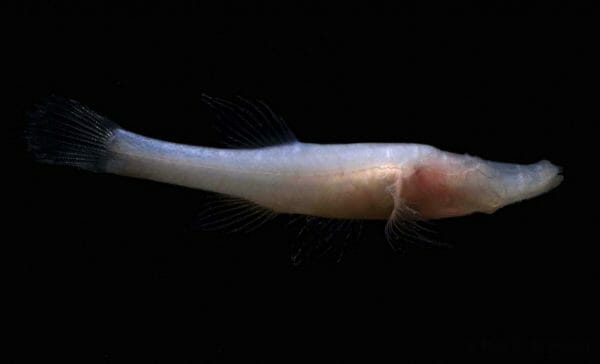 Alabama Cavefish
Alabama ranks fourth in species diversity in the United States, after Hawaii, Florida, and California. With regard to the number of species per acre, Alabama ranks second. Furthermore, the state of Alabama has the highest diversity in the nation for freshwater mussels, freshwater turtles, freshwater snails, and crayfish. Approximately 180 mussel species, or 60 percent of the nation’s mussels, occur in Alabama, and several species are endemic (native to a region and found nowhere else). Of all snails in the United States, 43 percent are found in Alabama and roughly 102 species are endemic. With more than 132,000 miles of perennial and intermittent rivers and streams and more than 500,000 acres of standing water, it is not surprising that Alabama has so many water-dependent species.
Alabama Cavefish
Alabama ranks fourth in species diversity in the United States, after Hawaii, Florida, and California. With regard to the number of species per acre, Alabama ranks second. Furthermore, the state of Alabama has the highest diversity in the nation for freshwater mussels, freshwater turtles, freshwater snails, and crayfish. Approximately 180 mussel species, or 60 percent of the nation’s mussels, occur in Alabama, and several species are endemic (native to a region and found nowhere else). Of all snails in the United States, 43 percent are found in Alabama and roughly 102 species are endemic. With more than 132,000 miles of perennial and intermittent rivers and streams and more than 500,000 acres of standing water, it is not surprising that Alabama has so many water-dependent species.
Alabama has approximately 117 endangered or threatened species listed and ranks third in the highest number of threatened and endangered species, behind Hawaii and California, but species are constantly being removed from or added to the list. Estimates suggest that nearly 100 species have become extinct in Alabama since colonial times. About half of the threatened and endangered species in Alabama are mussels. Ray-finned fishes form the next largest class of threatened and endangered animals. More than 20 percent of all species listed in Alabama were added to the list in 2001. This sizable growth reflects an increase in scientific knowledge about species distributions and habitat requirements.
Of the 105 animal species, 21 are no longer found in Alabama. These species are listed because they occurred historically in Alabama or because potential habitat in Alabama borders their current range. Conversely, the Alabama population of the smalltooth sawfish (Pristis pectinata) is not listed as threatened or endangered, even though it is listed federally and internationally, because Alabama’s populations of the fish are fairly large.
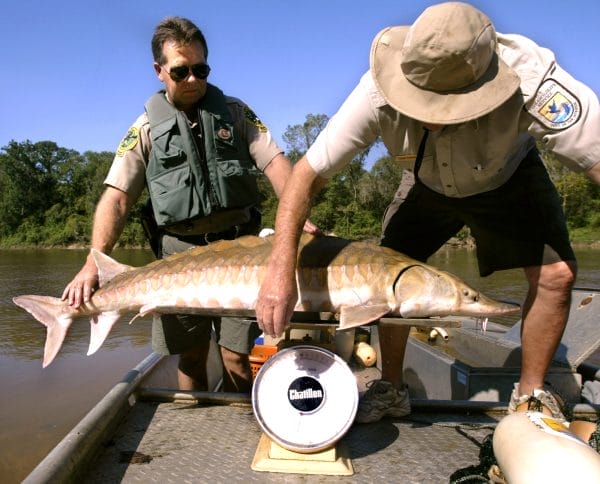 Gulf Sturgeon Research
Most of the state’s listed species are aquatic or dependent on water for feeding or reproduction. There are 14 river basins in Alabama. The Mobile River System, which includes the Tombigbee, Mobile, Alabama, Cahaba, Black Warrior, Coosa and Tallapoosa sub-basins, supports a great diversity of species, several of which are endemic. Dams, canals, mining, dredging, and direct and indirect pollution threaten this system and the species depending on it. During the past few decades, at least 12 species of mussels and 42 species of aquatic snails are presumed to have gone extinct. Currently, 37 aquatic animal species endemic to the Mobile River Basin are now protected under the ESA, including 2 turtles, 11 fish, 14 mussels, and 7 snails. A six-year recovery plan, established through a joint effort of the USFWS and the Mobile River Basin Coalition has been developed for the entire Mobile River Basin, focusing on 22 animal species, including 4 fish, 11 mussels, and 7 snails. This recovery plan focuses on protecting the habitat’s integrity and quality by working with the community on issues such as pollutants, research, education, technology, and restoration.
Gulf Sturgeon Research
Most of the state’s listed species are aquatic or dependent on water for feeding or reproduction. There are 14 river basins in Alabama. The Mobile River System, which includes the Tombigbee, Mobile, Alabama, Cahaba, Black Warrior, Coosa and Tallapoosa sub-basins, supports a great diversity of species, several of which are endemic. Dams, canals, mining, dredging, and direct and indirect pollution threaten this system and the species depending on it. During the past few decades, at least 12 species of mussels and 42 species of aquatic snails are presumed to have gone extinct. Currently, 37 aquatic animal species endemic to the Mobile River Basin are now protected under the ESA, including 2 turtles, 11 fish, 14 mussels, and 7 snails. A six-year recovery plan, established through a joint effort of the USFWS and the Mobile River Basin Coalition has been developed for the entire Mobile River Basin, focusing on 22 animal species, including 4 fish, 11 mussels, and 7 snails. This recovery plan focuses on protecting the habitat’s integrity and quality by working with the community on issues such as pollutants, research, education, technology, and restoration.
Animal Species Listed in Alabama
Mussels (Class Bivalvia)
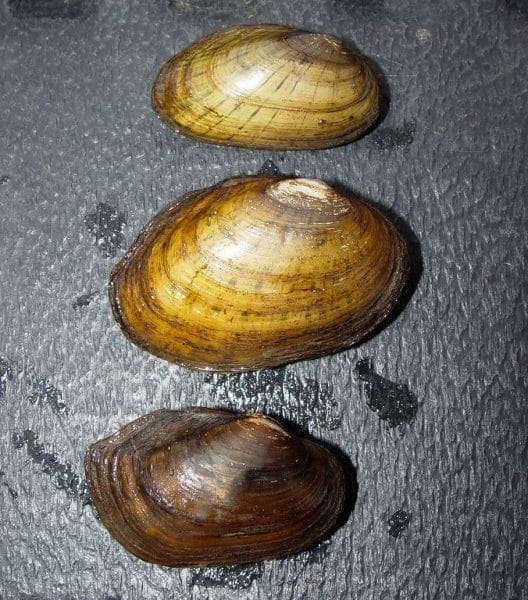 Paint Rock River Mussels
All mussels listed belong to the pearly mussel family (Unionidae). Pearly mussels live on stream bottoms and remain immobile throughout most of their lives, filtering out food particles from the water. Their lifecycle makes them very sensitive to stream pollution and thus provides scientists with an excellent means of assessing water quality. The large number of endangered mussel species in Alabama indicates that the state has water quality problems. Of the 180 species of mussel in Alabama, 7 are listed as threatened and 41 are listed as endangered. Many are considered critically endangered, meaning they are on the verge of extinction. The greatest threats to mussels are habitat modification, eutrophication (an overabundance of nutrients sometimes resulting from human influence), and other forms of water-quality degradation. Sources of these threats include dams, runoff from mining, and household and agricultural waste.
Paint Rock River Mussels
All mussels listed belong to the pearly mussel family (Unionidae). Pearly mussels live on stream bottoms and remain immobile throughout most of their lives, filtering out food particles from the water. Their lifecycle makes them very sensitive to stream pollution and thus provides scientists with an excellent means of assessing water quality. The large number of endangered mussel species in Alabama indicates that the state has water quality problems. Of the 180 species of mussel in Alabama, 7 are listed as threatened and 41 are listed as endangered. Many are considered critically endangered, meaning they are on the verge of extinction. The greatest threats to mussels are habitat modification, eutrophication (an overabundance of nutrients sometimes resulting from human influence), and other forms of water-quality degradation. Sources of these threats include dams, runoff from mining, and household and agricultural waste.
The endemic dark pigtoe (Pleurobema furvum) is endangered, as is the heavy pigtoe (Pleurobema taitianum), which is among the species endemic to the Mobile Basin. The heavy pigtoe, or Judge Tait’s mussel, was thought to be extinct, but in 1997 three live specimens were found in the Alabama River near Selma.
Numerous local, nonendemic mussels in the state of Alabama are endangered. They include the shinyrayed pocketbook (Lampsilis subangulata), shiny pigtoe (Fusconaia cor), white wartyback (Plethobasus cicatricosus), Alabama lampmussel (Lampsilis virescens), pink mucket (Lampsilis abrupta), and the fine-rayed pigtoe (Fusconaia cuneolus).
Species listed as endangered but not currently found in Alabama include the Cumberland bean (Villosa trabalis), clubshell (Pleurobema clava), Coosa moccasinshell (Medionidus parvulus), oval pigtoe (Pleurobema pyriforme), and littlewing pearlymussel (Pegias fabula).
Threatened species in the state of Alabama include: Chipola slabshell (Elliptio chipolaensis), Alabama heelsplitter (Potamilus inflatus), orangeacre mucket (Lampsilis perovalis), and Alabama moccasinshell (Medionidus acutissimus).
Snails (Class Gastropoda)
Most snails live in the shoals of streams and rivers with moderate to rapid currents, and they attach themselves to sand, gravel, or rocks. Historically, the Mobile River Basin was home to one of the most diverse aquatic snail faunas in the world, being home to more than 100 endemic species. The populations of many species were reduced greatly as a result of habitat flooding from dam construction and pollution, and at least 38 endemic snail species have become extinct. Sedimentation and eutrophication continue to threaten these animals.
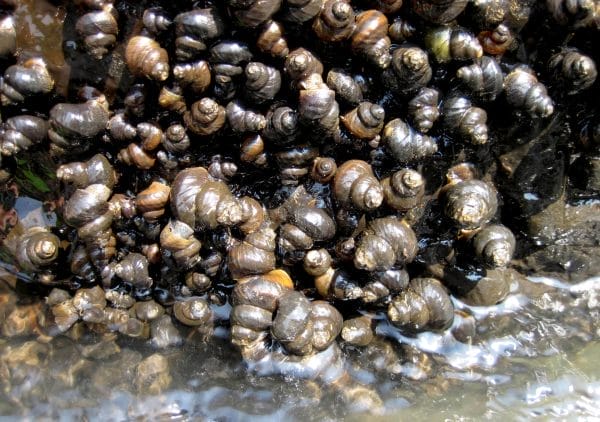 Tulotoma Snail Cluster
Currently, seven endangered and three threatened species of endemic snails from three families are listed. The cylindrical lioplax (Lioplax cyclostomaformis), tulotoma snail (Tulotoma magnifica) and slender campeloma (Campeloma decampi) belong to the family Vivaparidae, so called because they give birth to live snails, rather than laying eggs. The flat pebblesnail (Lepyrium showalteri), currently only known from one site on the Little Cahaba River and from a single shoal on the Cahaba River above the fall line, and the armored snail (Pyrgulopsis marstonia pachyta), known only from two creeks (Limestone and Piney) near Mooresville, are members of the Hydrobiidae family. A number of species from these two families are endangered. From the family Pleuroceridae, the plicate rocksnail (Leptoxis plicata), and Anthony’s riversnail (Athearnia anthonyi) are also listed as endangered. Populations of Anthony’s riversnail have been extirpated in almost their entire historic range, with the exception of one population in the Sequatchie River, in Marion County, Tennessee, and one in Limestone Creek, in Limestone County, Alabama.
Tulotoma Snail Cluster
Currently, seven endangered and three threatened species of endemic snails from three families are listed. The cylindrical lioplax (Lioplax cyclostomaformis), tulotoma snail (Tulotoma magnifica) and slender campeloma (Campeloma decampi) belong to the family Vivaparidae, so called because they give birth to live snails, rather than laying eggs. The flat pebblesnail (Lepyrium showalteri), currently only known from one site on the Little Cahaba River and from a single shoal on the Cahaba River above the fall line, and the armored snail (Pyrgulopsis marstonia pachyta), known only from two creeks (Limestone and Piney) near Mooresville, are members of the Hydrobiidae family. A number of species from these two families are endangered. From the family Pleuroceridae, the plicate rocksnail (Leptoxis plicata), and Anthony’s riversnail (Athearnia anthonyi) are also listed as endangered. Populations of Anthony’s riversnail have been extirpated in almost their entire historic range, with the exception of one population in the Sequatchie River, in Marion County, Tennessee, and one in Limestone Creek, in Limestone County, Alabama.
The three threatened species include the lacy elimia (Elimia crenatella), painted rocksnail (Leptoxis coosaensis), and round rocksnail (Leptoxis ampla), all of which belong to the family Pleuroceridae and are endemic to the Mobile River Basin.
Ray-Finned Fishes (Class Arctynopterygii)
All fish species listed for Alabama belong to three families of the class of ray-finned fishes. Water-quality degradation has reduced the range of most of these fish, and development, sewage pollution, strip-mining, and poor land-management practices have caused extirpation of many populations. Some species are also threatened by over-fishing.
 Vermilion Darter
Five listed species are endemic. The Alabama cavefish (Speoplatyrhinus poulsoni) is found only in the Key Cave in northwest Alabama. Very little is known about this critically endangered species. The watercress darter (Etheostoma nuchale) occupies areas of wild watercress growth in only in a few springs in central Alabama near Birmingham. The vermilion darter (Etheostoma chermocki) is known only from the Turkey Creek drainage. The Cahaba shiner (Notropis cahabae) was named after the only river this species inhabits. Given their very limited ranges, these four species are extremely sensitive to any disturbance and therefore endangered. Another threatened endemic species is the pygmy sculpin (Cottus pygmaeus) from Coldwater Spring near Anniston.
Vermilion Darter
Five listed species are endemic. The Alabama cavefish (Speoplatyrhinus poulsoni) is found only in the Key Cave in northwest Alabama. Very little is known about this critically endangered species. The watercress darter (Etheostoma nuchale) occupies areas of wild watercress growth in only in a few springs in central Alabama near Birmingham. The vermilion darter (Etheostoma chermocki) is known only from the Turkey Creek drainage. The Cahaba shiner (Notropis cahabae) was named after the only river this species inhabits. Given their very limited ranges, these four species are extremely sensitive to any disturbance and therefore endangered. Another threatened endemic species is the pygmy sculpin (Cottus pygmaeus) from Coldwater Spring near Anniston.
The amber darter (Percina antesella) is listed as endangered in Alabama, even though it is only found in the Conasauga river (Tennessee and Georgia), which is a tributary of the Coosa River in Alabama. The threatened spotfin chub (Cyprinella monacha) has not been found in Alabama since 1937. Furthermore, the threatened snail darter (Percina tanasi), initially reported from the lower Paint Rock River, has not been seen in recent surveys and may no longer live in Alabama.
Other endangered fish listed in Alabama include the boulder darter (Etheostoma wapiti), palezone shiner (Notropis albizonatus), and Alabama sturgeon (Scaphirhynchus suttkusi). The slackwater darter (Etheostoma boschungi), goldline darter (Percina aurolineata), blue shiner (Cyprinella caerulea), and gulf sturgeon (Acipenser oxyrinchus desotoi) are listed as threatened.
Arthropods (Arthropoda)
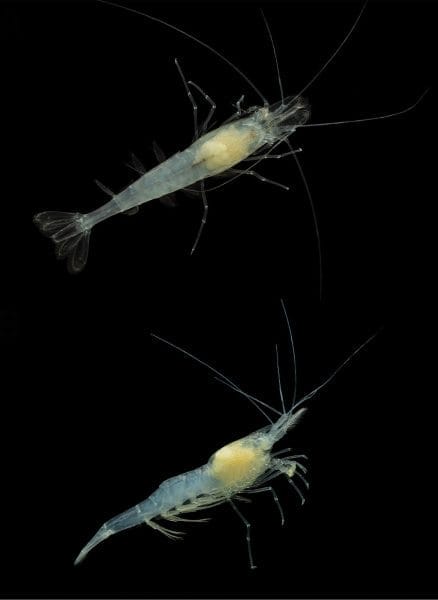 Alabama Cave Shrimp
Only two Alabama arthropods are listed as being endangered. The American burying beetle (Nicrophorus americanus) is critically endangered, having been reduced to 10 percent of its original range. In Alabama, this species is possibly extirpated, but surveys in suitable habitats are needed to confirm this. The Alabama cave shrimp (Palaemonias alabamae) is known only from Shelta Cave and Bobcat Cave in Madison County. The species has not been seen in Shelta Cave during recent surveys, but cave shrimp are transparent and therefore can be difficult to find.
Alabama Cave Shrimp
Only two Alabama arthropods are listed as being endangered. The American burying beetle (Nicrophorus americanus) is critically endangered, having been reduced to 10 percent of its original range. In Alabama, this species is possibly extirpated, but surveys in suitable habitats are needed to confirm this. The Alabama cave shrimp (Palaemonias alabamae) is known only from Shelta Cave and Bobcat Cave in Madison County. The species has not been seen in Shelta Cave during recent surveys, but cave shrimp are transparent and therefore can be difficult to find.
Amphibians (Class Amphibia)
Only one of three nationally listed amphibians is thought to occur still in Alabama. The Red Hills salamander (Ambystoma hubrichti) is found only in the Red Hills district (Tallahatta and Hatchetigbee siltstone formations) of south-central Alabama. This salamander was the first North American amphibian to receive federal protection, and it is the official state amphibian. Logging is one of the major threats to this species. The flatwoods salamander (Ambystoma cingulatum) has not been observed in Alabama since 1981. The Mississippi gopher frog (Rana capito sevosa), historically inhabiting the Mobile area, has not been seen there since 1922.
Reptiles (Class Reptilia, Class Eureptilia)
Most of threatened or endangered reptiles listed are turtles, which spend most of their life in water but come ashore to lay eggs. Thus it is difficult to know their exact distribution. Over-collecting for the pet trade, disease, and habitat degradation from sedimentation, pollution, and human disturbance to nesting sites constitute the greatest threats to turtles.
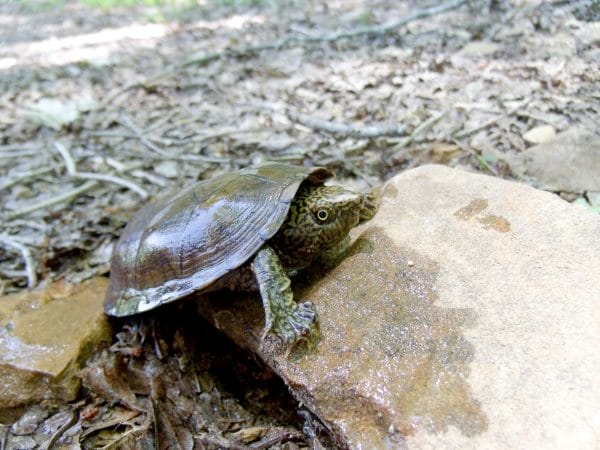 Juvenile Flattened Musk Turtle
Alabama’s single endemic turtle, the flattened musk turtle (Sternotherus depressus), is historically restricted to the upper Black Warrior River system in northern Alabama. Populations are in decline, and the species is listed currently as threatened. The Alabama red-bellied turtle (Pseudemys alabamensis) was endemic to Alabama, with the primary nesting site on Gravine Island in Baldwin County, but several additional nesting locations exist, and animals have recently been found in Mississippi. Listed species include the endangered green sea turtle (Chelonia mydas,), leatherback sea turtle (Dermochelys coriacea), and hawksbill sea turtle (Eretmochelys imbricata) and the threatened Kemp’s Ridley sea turtle (Lepidochelys kempii), loggerhead sea turtle (Caretta caretta), and gopher tortoise (Gopherus polyphemus).
Juvenile Flattened Musk Turtle
Alabama’s single endemic turtle, the flattened musk turtle (Sternotherus depressus), is historically restricted to the upper Black Warrior River system in northern Alabama. Populations are in decline, and the species is listed currently as threatened. The Alabama red-bellied turtle (Pseudemys alabamensis) was endemic to Alabama, with the primary nesting site on Gravine Island in Baldwin County, but several additional nesting locations exist, and animals have recently been found in Mississippi. Listed species include the endangered green sea turtle (Chelonia mydas,), leatherback sea turtle (Dermochelys coriacea), and hawksbill sea turtle (Eretmochelys imbricata) and the threatened Kemp’s Ridley sea turtle (Lepidochelys kempii), loggerhead sea turtle (Caretta caretta), and gopher tortoise (Gopherus polyphemus).
The longest North American snake, the threatened eastern indigo snake (Drymarchon corais couperi), is the only snake listed for Alabama. There are no known breeding populations of this snake in the state. Scientists are attempting to reintroduce the eastern indigo snake in Conecuh National Forest and other areas through a joint project of Auburn University, the University of Georgia, and conservation organizations.
The once endangered American alligator (Alligator mississippiensis) recovered rapidly after it received federal protection and is now considered secure. In Alabama, the alligator is not threatened or endangered, although under the ESA the alligator is still listed as threatened because of its similarity in appearance to other threatened or endangered crocodilians.
Birds (Class Aves)
 Red Cockaded Woodpecker
Five nonendemic birds from several families are listed. The Eskimo curlew (Numenius borealis), a shorebird, is not known to currently occur in Alabama, but it is still listed in the state as critically endangered because its large range extends from Canada to Argentina. The red-cockaded woodpecker (Dryobates borealis) still has a rather large range in the United States, but none of the significant populations are found in Alabama and numbers continue to decline as a result of habitat degradation. The endangered wood stork (Mycteria americana) and threatened piping plover (Charadrius melodus) have seasonal populations in the state. The bald eagle has a widespread distribution in North America. It is a nonbreeding resident of Alabama and although considered secure at the national level, it is listed as threatened in Alabama because of its susceptibility to environmental contaminants and human disturbance.
Red Cockaded Woodpecker
Five nonendemic birds from several families are listed. The Eskimo curlew (Numenius borealis), a shorebird, is not known to currently occur in Alabama, but it is still listed in the state as critically endangered because its large range extends from Canada to Argentina. The red-cockaded woodpecker (Dryobates borealis) still has a rather large range in the United States, but none of the significant populations are found in Alabama and numbers continue to decline as a result of habitat degradation. The endangered wood stork (Mycteria americana) and threatened piping plover (Charadrius melodus) have seasonal populations in the state. The bald eagle has a widespread distribution in North America. It is a nonbreeding resident of Alabama and although considered secure at the national level, it is listed as threatened in Alabama because of its susceptibility to environmental contaminants and human disturbance.
Mammals (Class Mammalia)
Historically, mammal populations were greatly affected by hunting, but they are mainly threatened now by habitat degradation. In Alabama, two bats, two rodents, two carnivores, and two whales are listed as endangered. Among these, the gray wolf (Canis lupus), the Florida panther (Felis concolor coryi), and the, Perdido Key beach mouse (Peromyscus polionotus trissyllepsis) are listed but do not currently occur in Alabama. The Alabama beach mouse (Peromyscus polionotus ammobates) is the last of the endemic mammal species in Alabama.
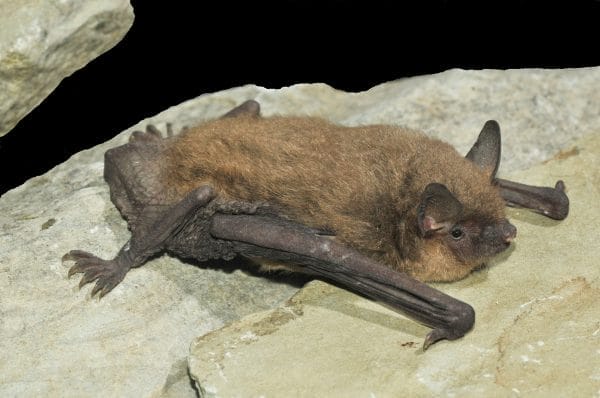 Gray Bat
The other listed species include the Indiana bat (Myotis sodalis), gray bat (Myotis grisescens), finback whale (Balaenoptera physalus) and humpback whale (Magaptera novaeangliae). The finback whale is one of 60 species under NMFS management.
Gray Bat
The other listed species include the Indiana bat (Myotis sodalis), gray bat (Myotis grisescens), finback whale (Balaenoptera physalus) and humpback whale (Magaptera novaeangliae). The finback whale is one of 60 species under NMFS management.
Authorities are continually evaluating the status of species in Alabama and more focus has been put on preserving and restoring habitat. Nonprofit organizations such as the Nature Conservancy and the Wildlife Habitat Council, in coordination with numerous state agencies, are working towards conservation efforts that include managing and regulating Alabama’s forests, parks, wetlands and recreational areas.
Further Reading
- “Atlanta: Mobile River Basin Aquatic Ecosystem Recovery Plan.” Washington, D.C.: U.S. Fish and Wildlife Service, 2000.
- “Recovery Plan for Six Mobile River Basin Aquatic Snails.” Jackson, Miss.: U.S. Fish and Wildlife Service, 2005.



